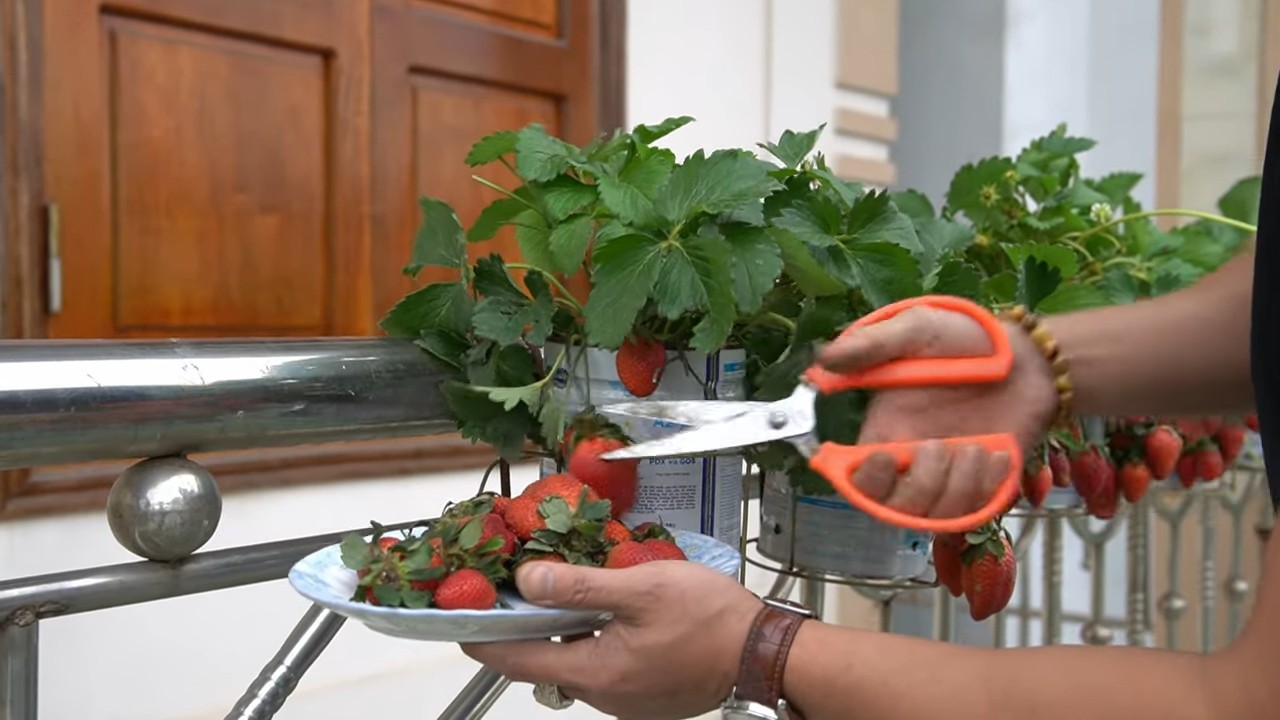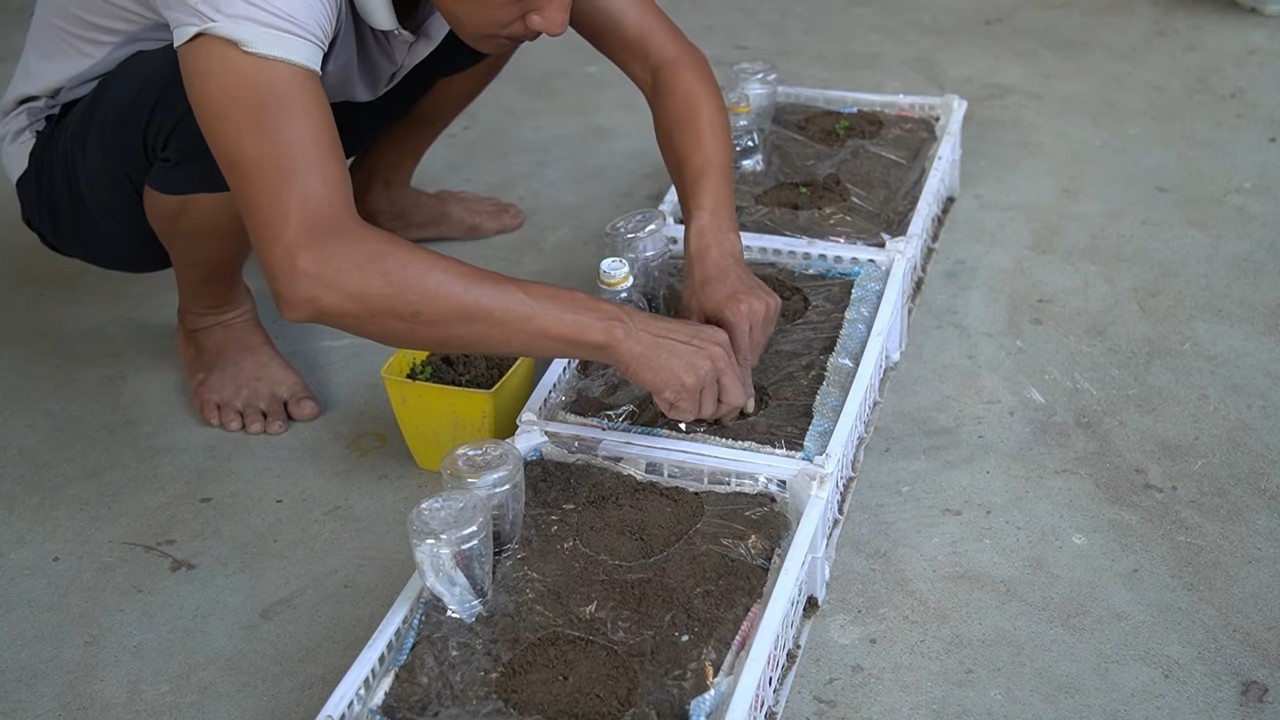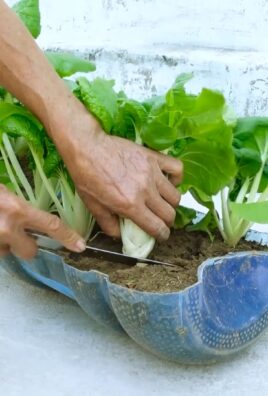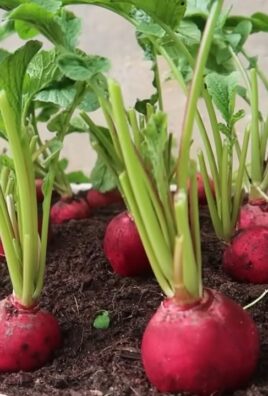Balcony Strawberry Growing – dreaming of juicy, sun-ripened strawberries but only have a small balcony to work with? You’re not alone! For centuries, people have cultivated strawberries in various ways, from sprawling garden beds to ingenious vertical systems. In fact, evidence suggests that the Romans were enjoying cultivated strawberries as far back as the 2nd century AD! But let’s face it, not everyone has the luxury of a sprawling Roman villa (or even a small backyard!).
That’s where this DIY guide comes in. I’m going to show you how to transform your humble balcony into a thriving strawberry patch, no matter how limited your space. Imagine stepping outside and picking fresh, sweet strawberries for your morning cereal or a delicious afternoon snack. No more trips to the grocery store for bland, overpriced berries!
This article is packed with simple, effective tricks and hacks that will help you maximize your yield and minimize the effort involved in balcony strawberry growing. We’ll cover everything from choosing the right containers and soil to providing the perfect amount of sunlight and water. So, grab your gardening gloves, and let’s get started on creating your own little strawberry paradise!

DIY Balcony Strawberry Paradise: A Step-by-Step Guide
Hey there, fellow balcony gardeners! Dreaming of juicy, sun-ripened strawberries just steps from your door? Well, you’ve come to the right place. I’m going to walk you through creating your very own strawberry haven, even if you only have a small balcony space. Get ready to enjoy fresh, homegrown berries all season long!
Choosing the Right Strawberries and Containers
Before we dive into the nitty-gritty, let’s talk about the stars of the show: the strawberries themselves! And, of course, where they’ll be living.
* Strawberry Varieties: Not all strawberries are created equal, especially for container gardening.
* Everbearing: These are my personal favorites for balconies. They produce fruit throughout the growing season, giving you a steady supply of berries.
* Day-Neutral: Similar to everbearing, day-neutral varieties are less sensitive to day length and will produce fruit continuously as long as the temperature is right.
* June-Bearing: These produce a large crop of strawberries all at once, usually in June (hence the name). While delicious, they might not be the best choice if you want a continuous harvest.
* Alpine Strawberries: These are smaller, intensely flavored berries that are perfect for snacking. They also tend to be more shade-tolerant than other varieties.
* Container Options: The possibilities are endless!
* Hanging Baskets: These are great for maximizing vertical space and creating a beautiful display.
* Strawberry Pots: These terracotta pots have pockets along the sides, perfect for planting multiple strawberry plants in a small space.
* Grow Bags: Lightweight and affordable, grow bags are a great option for balconies.
* Traditional Pots: Any pot with good drainage will work, just make sure it’s large enough for the strawberry plants to spread out. Aim for at least 12 inches in diameter.
* Vertical Pallet Gardens: If you’re feeling ambitious, you can create a vertical strawberry garden using a repurposed pallet.
Materials You’ll Need
Okay, let’s gather our supplies. Here’s what you’ll need to get started:
* Strawberry plants (your chosen variety)
* Containers (hanging baskets, strawberry pots, grow bags, or traditional pots)
* Potting mix (specifically formulated for containers)
* Slow-release fertilizer (for strawberries)
* Watering can or hose
* Trowel or small shovel
* Gardening gloves (optional, but recommended)
* Mulch (straw, wood chips, or pine needles)
* Bird netting (to protect your precious berries from hungry birds)
Step-by-Step Planting Guide
Alright, let’s get our hands dirty! Here’s how to plant your strawberry plants in containers:
1. Prepare Your Containers:
* Make sure your containers have drainage holes. If not, drill some! Strawberries don’t like soggy roots.
* Line the bottom of your containers with a layer of gravel or broken pottery shards to improve drainage.
2. Fill with Potting Mix:
* Fill your containers with high-quality potting mix, leaving a few inches of space at the top. Don’t use garden soil, as it can compact and doesn’t drain well in containers.
3. Plant Your Strawberries:
* Gently remove the strawberry plants from their nursery pots.
* Loosen the roots slightly with your fingers.
* Dig a hole in the potting mix that’s large enough to accommodate the root ball.
* Place the strawberry plant in the hole, making sure the crown (the point where the stems meet the roots) is level with the soil surface. Planting too deep can cause the plant to rot.
* Fill in the hole with potting mix and gently firm the soil around the plant.
* Space the plants according to the variety’s recommendations. Generally, allow about 8-12 inches between plants.
4. Water Thoroughly:
* Water the newly planted strawberries thoroughly until water drains out of the drainage holes. This helps settle the soil and encourages root growth.
5. Add Mulch:
* Apply a layer of mulch around the base of the plants. Mulch helps retain moisture, suppress weeds, and keep the berries clean. Straw is a classic choice, but wood chips or pine needles also work well.
6. Fertilize:
* Apply a slow-release fertilizer specifically formulated for strawberries according to the package directions. This will provide the plants with the nutrients they need to thrive and produce lots of berries.
Caring for Your Balcony Strawberry Garden
Now that your strawberries are planted, it’s time to learn how to keep them happy and healthy.
* Watering:
* Strawberries need consistent moisture, especially when they’re fruiting. Water deeply whenever the top inch of soil feels dry to the touch. Avoid overwatering, as this can lead to root rot.
* Water in the morning to allow the foliage to dry before nightfall, which helps prevent fungal diseases.
* Sunlight:
* Strawberries need at least 6-8 hours of sunlight per day to produce a good crop of berries. Place your containers in the sunniest spot on your balcony.
* Fertilizing:
* Continue to fertilize your strawberries every 4-6 weeks with a balanced fertilizer.
* Pruning:
* Remove any dead or yellowing leaves to keep the plants healthy.
* Pinch off runners (the long stems that the plants send out) unless you want to propagate new plants. Runners take energy away from fruit production.
* Pest and Disease Control:
* Keep an eye out for pests like aphids, spider mites, and slugs. Treat infestations promptly with insecticidal soap or neem oil.
* Prevent fungal diseases by providing good air circulation and avoiding overwatering.
* Protecting Your Berries:
* Birds love strawberries just as much as we do! Cover your plants with bird netting to protect your precious berries from being eaten.
* Slugs and snails can also be a problem. Use slug bait or handpick them off the plants.
Harvesting Your Strawberries
The moment you’ve been waiting for! Harvesting your own homegrown strawberries is one of the most rewarding experiences.
* When to Harvest:
* Strawberries are ready to harvest when they are fully red and slightly soft to the touch.
* The berries should easily detach from the plant when gently pulled.
* How to Harvest:
* Gently grasp the strawberry and twist it off the plant, leaving a small piece of the stem attached.
* Enjoy Your Harvest:
* Eat your strawberries fresh, use them in desserts, or make jam. The possibilities are endless!
Troubleshooting Common Strawberry Problems
Even with the best care, you might encounter some problems along the way. Here are a few common issues and how to fix them:
* Yellowing Leaves: This could be a sign of overwatering, nutrient deficiency, or pest infestation. Adjust your watering schedule, fertilize the plants, and check for pests.
* No Fruit Production: This could be due to lack of sunlight, poor pollination, or nutrient deficiency. Make sure your plants are getting enough sunlight, hand-pollinate the flowers if necessary, and fertilize the plants.
* Small Berries: This could be caused by lack of water, nutrients, or sunlight. Water the plants regularly, fertilize them, and make sure they’re getting enough sunlight.
* Rotting Berries: This is usually caused by fungal diseases. Improve air circulation, avoid overwatering, and remove any infected berries.
Extending Your Strawberry Season
Want to enjoy strawberries for even longer? Here are a few tips for extending your strawberry season:
* Succession Planting: Plant new strawberry plants every few weeks to ensure a continuous harvest.
* Cold Frames: Use cold frames to protect your plants from frost and extend the growing season in the fall and winter.
* Overwintering: Protect your strawberry plants from the cold by covering them with a layer of mulch or moving them to a sheltered location.
Creative Strawberry Container Ideas
Want to get creative with your strawberry containers? Here are a few ideas to inspire you:
* Strawberry Towers: Build a tall, tiered strawberry tower using PVC pipes or other materials.
* Hanging Gutter Gardens: Repurpose old gutters into hanging planters for strawberries.
* Strawberry Spheres: Create a hanging sphere covered in strawberry plants.
* Upcycled Containers: Use old tires, buckets, or other recycled materials as planters for strawberries.
Propagating New Strawberry Plants
Want to expand

Conclusion
So, there you have it! Transforming your balcony into a thriving strawberry patch is not only achievable, but also incredibly rewarding. We’ve explored the simple yet effective methods for cultivating delicious, juicy strawberries right outside your door. Forget those bland, store-bought berries – imagine plucking sun-ripened sweetness straight from the vine, knowing you nurtured them from tiny seedlings to plump, red jewels. This DIY balcony strawberry growing adventure is more than just a gardening project; it’s an investment in fresh, healthy eating, a connection to nature, and a delightful hobby that can brighten your day.
Why is this a must-try? Because it democratizes access to fresh produce. You don’t need acres of land to enjoy the taste of homegrown strawberries. A small balcony, a few containers, and a little bit of love are all you need to embark on this flavorful journey. Plus, think of the environmental benefits! You’re reducing your carbon footprint by cutting down on transportation and packaging associated with store-bought produce. You’re also creating a haven for pollinators, contributing to a healthier ecosystem right in your urban environment.
But the best part? The sheer joy of watching your plants flourish. There’s something deeply satisfying about nurturing life, from planting the seeds to harvesting the fruits of your labor. And let’s be honest, the taste of a homegrown strawberry is simply unparalleled. It’s sweeter, juicier, and bursting with flavor in a way that store-bought berries can only dream of.
Don’t be afraid to experiment! Try different varieties of strawberries to find your favorites. Everbearing varieties will provide a continuous harvest throughout the growing season, while June-bearing varieties offer a larger crop all at once. Consider adding companion plants like basil or marigolds to deter pests and attract beneficial insects. You can also explore different container options, from traditional pots to hanging baskets to vertical planters, to maximize your space and create a visually stunning display.
For a unique twist, try growing alpine strawberries. These tiny berries are incredibly flavorful and perfect for snacking. They also tend to be more shade-tolerant than other varieties, making them a great option for balconies that don’t receive full sun. Another variation is to create a tiered strawberry tower using stacked planters. This is a fantastic way to maximize vertical space and create a dramatic focal point on your balcony. You can even incorporate other herbs and flowers into your strawberry tower for added visual appeal and functionality.
We encourage you to take the plunge and give this DIY balcony strawberry growing trick a try. It’s easier than you think, and the rewards are immeasurable. Once you taste your first homegrown strawberry, you’ll be hooked!
And most importantly, we want to hear about your experience! Share your photos, tips, and stories with us in the comments below. Let us know what varieties you’re growing, what challenges you’ve faced, and what successes you’ve celebrated. Together, we can create a community of balcony strawberry growers, sharing our knowledge and inspiring others to cultivate their own little slice of paradise. So go ahead, get your hands dirty, and experience the joy of growing your own delicious strawberries!
Frequently Asked Questions (FAQ)
What kind of soil should I use for my balcony strawberries?
Strawberries thrive in well-draining, slightly acidic soil. A good potting mix specifically formulated for fruits and vegetables is ideal. You can also amend regular potting mix with compost or peat moss to improve drainage and add nutrients. Avoid using garden soil, as it can be too heavy and may contain pests or diseases. The ideal pH range for strawberry soil is between 5.5 and 6.5. You can test your soil’s pH using a simple soil testing kit available at most garden centers. If your soil is too alkaline, you can lower the pH by adding sulfur or peat moss.
How much sunlight do balcony strawberries need?
Strawberries need at least 6-8 hours of direct sunlight per day to produce a good crop of berries. Choose a location on your balcony that receives ample sunlight throughout the day. If your balcony is shaded for part of the day, try to position your strawberry plants so they receive morning sun, which is less intense than afternoon sun. If you don’t have enough natural sunlight, you can supplement with grow lights. LED grow lights are energy-efficient and can provide the necessary light spectrum for healthy strawberry growth.
How often should I water my balcony strawberries?
Water your strawberry plants regularly, especially during hot, dry weather. The soil should be kept consistently moist, but not soggy. Water deeply whenever the top inch of soil feels dry to the touch. Avoid overhead watering, as this can promote fungal diseases. Instead, water at the base of the plants, using a watering can or a soaker hose. During the dormant season (winter), reduce watering frequency, but don’t let the soil dry out completely.
What kind of fertilizer should I use for my balcony strawberries?
Strawberries are heavy feeders and benefit from regular fertilization. Use a balanced fertilizer specifically formulated for fruits and vegetables. Look for a fertilizer with an N-P-K ratio of around 10-10-10 or 12-12-12. Fertilize your plants every 2-4 weeks during the growing season, following the instructions on the fertilizer package. You can also use organic fertilizers, such as compost tea or fish emulsion. These are gentler on the plants and provide a slow-release source of nutrients. Avoid over-fertilizing, as this can lead to excessive foliage growth and fewer berries.
How do I protect my balcony strawberries from pests and diseases?
Monitor your strawberry plants regularly for signs of pests or diseases. Common pests include aphids, spider mites, and slugs. You can control aphids and spider mites with insecticidal soap or neem oil. Slugs can be controlled with slug bait or by hand-picking them off the plants. Common diseases include powdery mildew and gray mold. To prevent these diseases, ensure good air circulation around your plants and avoid overhead watering. If you notice signs of disease, remove the affected leaves or berries and treat the plants with a fungicide. Consider using companion planting to deter pests naturally.
How do I overwinter my balcony strawberries?
In colder climates, you’ll need to protect your strawberry plants from freezing temperatures. Move your containers to a sheltered location, such as a garage or shed. If you can’t move the containers, wrap them in burlap or bubble wrap to insulate the roots. Water the plants sparingly during the winter, just enough to keep the soil from drying out completely. In the spring, gradually acclimate the plants to outdoor conditions before moving them back to their sunny location.
Can I grow strawberries in hanging baskets on my balcony?
Yes, strawberries grow very well in hanging baskets. Choose a hanging basket that is at least 12 inches in diameter and has good drainage. Use a lightweight potting mix and water regularly. Hanging baskets tend to dry out more quickly than containers on the ground, so check the soil moisture frequently. Fertilize your hanging basket strawberries regularly, as the nutrients can leach out more quickly.
What are the best varieties of strawberries to grow on a balcony?
Some of the best varieties of strawberries to grow on a balcony include:
* **Everbearing varieties:** These varieties produce berries throughout the growing season. Examples include Albion, Seascape, and Ozark Beauty.
* **June-bearing varieties:** These varieties produce a large crop of berries all at once, typically in June. Examples include Chandler, Honeoye, and Earliglow.
* **Alpine strawberries:** These tiny berries are incredibly flavorful and perfect for snacking. They are also more shade-tolerant than other varieties.
Choose a variety that is well-suited to your climate and growing conditions.
How do I know when my strawberries are ripe?
Strawberries are ripe when they are fully red and slightly soft to the touch. The berries should also detach easily from the plant. Avoid picking strawberries that are still green or white, as they will not ripen further after being picked. The best time to harvest strawberries is in the morning, after the dew has dried.
How long will my balcony strawberry plants produce berries?
Strawberry plants typically produce berries for 3-5 years. After that, the plants may become less productive and need to be replaced. You can propagate new strawberry plants from runners, which are stems that grow out from the main plant. Simply plant the runners in new containers and they will root and grow into new plants.




Leave a Comment